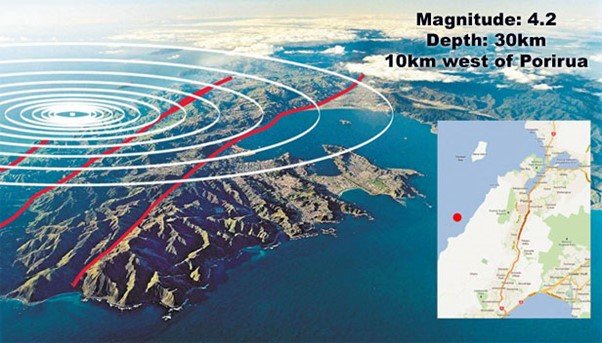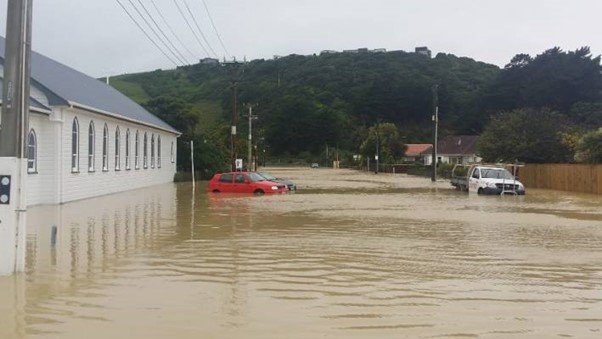Natural hazards are the threat of naturally occurring events that may have a negative effect on people or the environment. They include earthquakes, and extreme weather events such as storms, floods, and landslides.
- Earthquakes
- Tsunamis
- Floods
Earthquakes
All New Zealand is at risk of earthquakes. We can’t predict when one will happen, but we can protect ourselves and our whanau.

- Practise your DROP, COVER and HOLD
- Most injuries and deaths during earthquakes are caused by falling objects rather than buildings collapsing. You need to practise your DROP, COVER and HOLD to help make it your automatic response when the ground starts shaking.
- Think about safe places to DROP, COVER and HOLD
- Somewhere close to you, no more than a few steps away, to avoid injury from flying debris.
- Under a strong table: hold on to the table legs to keep it from moving.
- Next to an interior wall: away from windows that can shatter and cause injury, and tall furniture that can fall on you.
- Protect your head and neck with your arms.
- Not in a doorway: in most homes, doorways are no stronger than any other part on the house and a swinging door could cause more injury.
- If you are unable to DROP, COVER and HOLD - brace yourself as best you can and try to find a way to protect your head and neck.
- If you have a disability or mobility assistance needs
- If you use a cane, DROP, COVER and HOLD or sit on a chair or bed and cover your head and neck with both hands. Keep your cane near you so it can be used when the shaking stops.
- If you use a walker or wheelchair, Lock, Cover and Hold. LOCK your wheels (if applicable). If using a walker carefully get as low as possible. Bend over and COVER your head and neck as best you can. Then HOLD on until the shaking stops.
Resources
- Find information and resources for people with disabilities or special requirements at GetReady.govt.nz
- Find out how to make your home safer
During an earthquake

If you are in these locations:
- Indoors- stay indoors and DROP, COVER and HOLD, until the shaking stops.
- In bed - stay in bed, pull the sheets and blankets over you, and use your pillow to protect your head and neck. You are less likely to be injured if you stay in bed.
- In a tall building - don't rush outside just because the fire alarms go off. Read advice for people living in apartments
- In an elevator - DROP, COVER and HOLD. When the shaking stops, try to get out at the nearest floor if you can safely do so.
- Outdoors - move away from buildings, trees, and power lines, then DROP, COVER and HOLD until the shaking stops.
- On a busy city street - don't stay on the footpath as things might fall on you from the buildings around you. Quickly move into a building, then DROP, COVER and HOLD.
- Driving a car - PULL OVER and WAIT - pull over to a clear location, stop and stay there with your seatbelt fastened until the shaking stops. Once the shaking stops, proceed with caution and avoid bridges or ramps as they may have been damaged.
- At home - In modern homes, doorways are no stronger than any other part of the structure and usually have doors that can swing and injure you. Drop, cover, hold is recommended for New Zealand buildings.
Don't immediately run outside:
- Wait: While your instinct might be to get outside, our buildings in New Zealand are designed to remain standing during an earthquake and allow people to leave safely afterwards.
- Assess: When the shaking stops, assess the situation and whether you need to go outside. It may be more dangerous outside than inside. There could be aftershocks which may cause more objects to fall and live wires could be exposed.
- Exit carefully: When you decide to go outside, exit the building carefully by looking up and around you to check for things that might fall on you or injure you - for example, furniture and fittings, heating/cooling systems, decorative masonry, glass/windows, power lines, trees and rocks/boulders on a hillside.
After an earthquake

Expect more shaking. Each time you feel earthquake shaking, DROP, COVER and HOLD. More shaking can happen minutes, days, weeks, months and even years following an earthquake.
- Check yourself for injuries and get first aid if necessary.
- Stay up to date with information by listening to the radio and following WREMO on Facebook and Twitter.
- Turn off water, electricity and gas if advised to. If you smell gas or hear a blowing or hissing noise, open a window, get everyone out quickly and turn off the gas if you can.
- If you see sparks, broken wires or evidence of electrical system damage, turn off the electricity at the main fuse box if it is safe to do so.
- If you can, put on protective clothing that covers your arms and legs, and sturdy footwear. This is to protect yourself from injury by broken objects.
- If you are in a store, unfamiliar building or on public transport, follow the instructions of those in charge.
- Use social media or text messages instead of calling to keep phone lines clear for emergency calls. Tip: Consider changing your voicemail to let your friends/family know you are safe.
- Keep control of your pets. Protect them from hazards and protect other people from your animals.
- Check on your neighbours and anyone who might need your help.
If your property is damaged:
- Contact your insurance company as soon as possible. If you rent your property, contact your landlord and your contents insurance company.
- Take photos of any damage once it is safe to do so. It will help speed up assessments of your claims.
Resources
- Find information and resources for people with disabilities or special requirements (GetReady.govt.nz)
- Find out how to make your home safer.
- Attend a Household Earthquake Planning Session [LINK TO SIGN UP]
- It's Our Fault (GNS Science)
- Science Topics: Earthquakes (GNS Science)
- Quakes (Geonet)
- Hikurangi Subduction Zone Earthquakes and Slip Behaviour project and video recording of public talk (East Coast LAB)

Tsunamis
When there is an earthquake in the open ocean, shockwaves caused by the earthquake can produce series of fast-moving waves or surges, known as tsunamis, that can move at speeds of between speeds of 600–700 km/hr towards land.
Flooding
Floods are the most frequently occurring natural hazard in the Wellington region. They present a high risk due to the large-scale damage they can cause. Rivers can flood due to high rainfall, and urban areas can be flooded from blocked or inadequate drainage.

- Find out what you can do to prepare for rain and any flooding
- Check the Wellington Water modelled Flood Map to see if where you live, work, or play is prone to flooding.
- Create a plan for if access to your house is cut off, or you need to evacuate due to flooding. Ensure you have a grab bag ready to go and a plan for your pets and/or livestock.
- Make a household for the safest evacuation routes you could take. All members of the household should know where to evacuate to, what routes to take if you need to leave, and where to meet each other afterwards.
- If flooding is expected - move your valuables/furniture upstairs. Use watertight containers to store important items.
- Lift curtains, rugs and bedding off the floor.
- Bring outdoor belongings, such as patio furniture, indoors.
If flooding is expected, consider using sandbags to keep water away from your home.
During Flooding

- Prepare to evacuate quickly, follow your emergency plan, take your grab bag and pets with you. If you feel unsafe - self-evacuate, don't wait for an official warning.
- Listen to the radio and follow instructions of emergency services.
- Turn around don't drown! Stay out of flood water - never try to walk, swim, or drive through flood water. Many flood fatalities are caused by people attempting to travel through flood water.
- Always assume that flood water is contaminated with farm run-off, chemicals, and sewage. Contaminated flood water can make you sick. Make sure you wash your hands, clothes, and property after contact with flood waters.
- Turn off water, electricity and gas if advised.
- Check on your neighbours and anyone who may need your help.
After Flooding

- If you have evacuated, you should only return home once officials advise it is safe to do so. It may not be safe even when flood waters have receded.
- Look before you step - the ground may be slippery or covered with debris including broken glass. Stay away from damaged areas.
- Help others if you can.
- If your property is damaged, contact your insurance company as soon as possible. If you rent your property, contact your landlord and contents insurance company.
- Once home, throw away any food, including canned goods, or drinking water that has come into contact with flood water as it may be contaminated. Avoid drinking or preparing food with flood water until you are certain it is not contaminated.
- Follow any boil water notice instructions from your local council.
- Clean up carefully and take care around remaining flood water - you may need to wear protective gear such as gloves, sturdy footwear and protective clothing that covers your arms and legs.
- Take photos, for your insurer, of any items you throw away.


